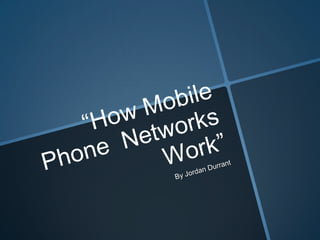
How Mobile Phone Networks Work
- 1. “How Mobile Phone Networks Work” By Jordan Durrant
- 2. Radio Communication Radio has been used as form of communication for hundreds of years. Since Marconi’s discovery in 1895, radio has been used in broadcasting and for two-way radio communication by the military and the police. The invention of radio has revolutionised the face of technology completely.
- 3. What is a Radio Wave? Radio waves are emitted by both natural and man-made sources, artificially generated waves are generated for use in satellites, broadcasting etc. Radio waves are a part of the electromagnetic spectrum, All electromagnetic radiation consists of oscillating electric and magnetic fields and the frequency, which is the number of times per second at which the wave oscillates, determines their properties and the use that can be made of them.
- 4. Frequencies Frequencies are measured in hertz or Hz, where 1 Hz is one oscillation per second, 1 kHz a thousand, 1 MHz is a million, and 1 GHz, is a thousand million. Frequencies between 30 kHz and 300 GHz are commonly used for broadcast radio and television.180 kHz and 1.6 MHz are the frequencies used in the UK, FM radio ranges from 88 to 108 MHz, and TV ranges from 470 to 854 MHz. Cellular mobile services operate within the frequency ranges 872-960 MHz, 1710-1875 MHz and 1920 - 2170 MHz. Waves with a higher frequency are called Microwaves, and have a wide variety of uses. These include radar, telecommunication links, satellite communications, weather observation and medical diathermy.
- 5. Radio Communication A radio frequency wave used for radio communication is referred to as a carrier wave. This is then converted to a sine wave, A sine wave conveys very little information since it simply repeats over and over. It can then be switched on or off, the technique used for early radio transmissions like Morse Code. Modulation is required to convey more information like data and speech. The modulation process involves some feature of the carrier wave being varied in accordance with the information transmitted.
- 6. Amplitude Modulation In Amplitude Modulation, the electrical signal from a microphone produced by speech or music is used to vary the amplitude of the carrier wave, so that at any instant the size or amplitude of the RF carrier wave is made proportional to the size of the electrical modulating signal. AM has many advantages and disadvantages. Firstly, an AM signal can operate over high distances, furthermore, they are cost efficient as well. On the other hand, AM can suffer from interference, its also prone to high levels of noise due to its amplitude. Amplitude Modulation
- 7. Mobile Phones and Cellular Radio The diagram above illustrates the cell structure of a mobile phone network. It consists of a hexagonal mesh each with a base centre. A mobile phone uses radio networking to operate, a signal is sent from the phone to the nearest base station and incoming signals (carrying the speech from the person to whom the phone user is listening) are sent from the base station to the phone at a slightly different frequency. Once the signal reaches a base station it can be transmitted to the main telephone network, either by telephone cables or by higher frequency radio links between an antenna (e.g. dish) at the base station and another at a terminal connected to the main telephone network.
- 8. Base Stations Transmitted signal strength falls off rapidly with distance from base stations, and mobile phones require a certain minimum signal strength to ensure adequate reception. The current generation of GSM base stations cannot communicate over distances greater than 35 km because the delay in receiving radio signals becomes too great. However, the decline of signal strength with distance places a practical limit on coverage of around 10 km. For these reasons an extensive network of base stations is needed to ensure coverage throughout the UK. Radio spectrum is a precious natural resource with many different demands upon it (for example, radio and TV broadcasting, emergency communication, navigation aids etc). Consequently the amount made available to each mobile phone operator is limited and this means base stations can only carry a limited number of calls at any one time. To accommodate the steadily increasing volume of users, network operators have to use the limited number of radio frequencies licensed to them to support the maximum number of mobile phone users. This is achieved by re-using any given radio frequency many times in a network and carefully controlling base station power so that signals arising in different parts of the network do not interfere with each other. This concept of frequency re-use is illustrated in figure 3. The cells are grouped into clusters, with the frequencies allocated to a particular cell within a cluster not being re-used until the corresponding cell in adjacent clusters. This gives a repeating pattern of cells and clusters which can be expanded to provide national coverage. To increase the capacity of their networks, operators have to build additional base stations and thus reduce cell size. It is for this reason that one large base station cannot serve a whole town.
- 9. Types of Mobile Phone Technology There are two different kinds of mobile phone technology involving frequency. GSM and UMTS. GSM Global system for Mobile Communications or GroupeSpeciale Mobile. The international, pan-European operating standard for the current generation of digital cellular mobile communications. It enables mobile phones to be used across national boundaries. In the UK this technology operates in the 900 MHz and 1800 MHz frequency bands. UMTS Universal Mobile Telecommunication System .The next generation of mobile phone technology, expected to result in widespread use of video phones and access to multimedia information. In the UK this technology operates in 2 GHz region.
- 10. Reference Slide Public Telecommunication Networks Unit. (2001). How Mobile Phone Networks Work. Available: http://www.sitefinder.ofcom.org.uk/mobilework.htm. Last accessed 21 Jan 2011.